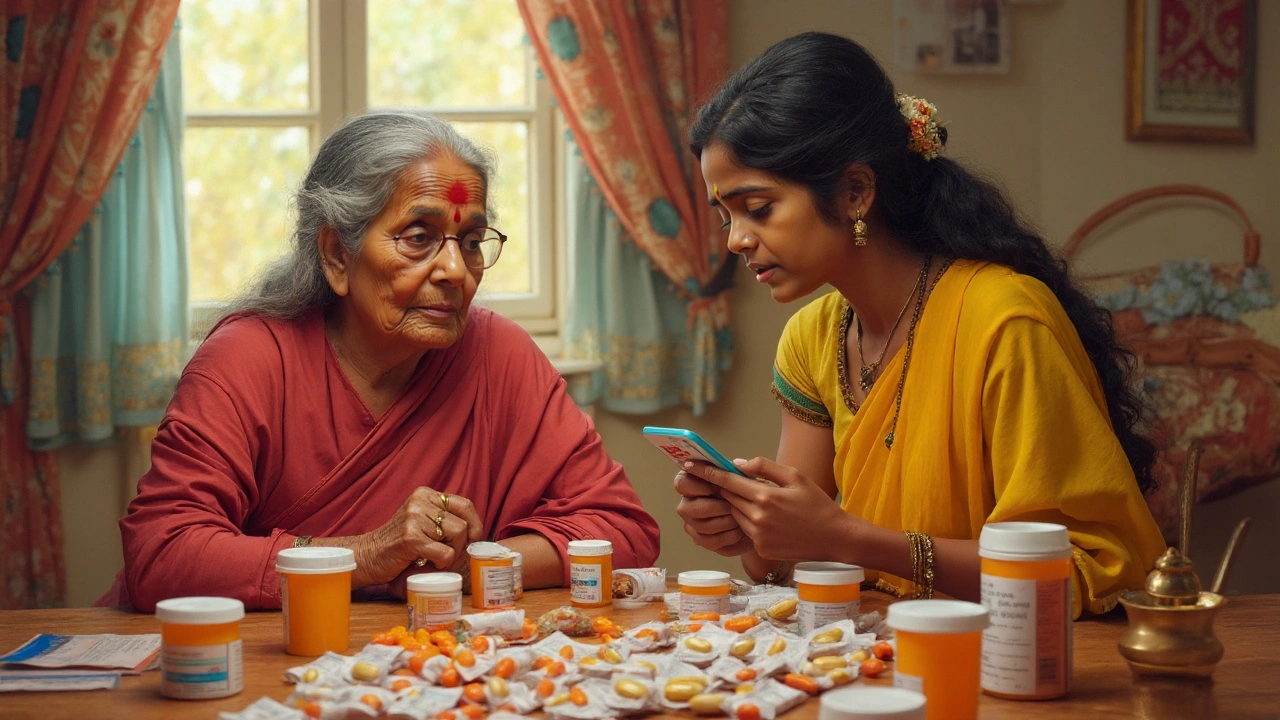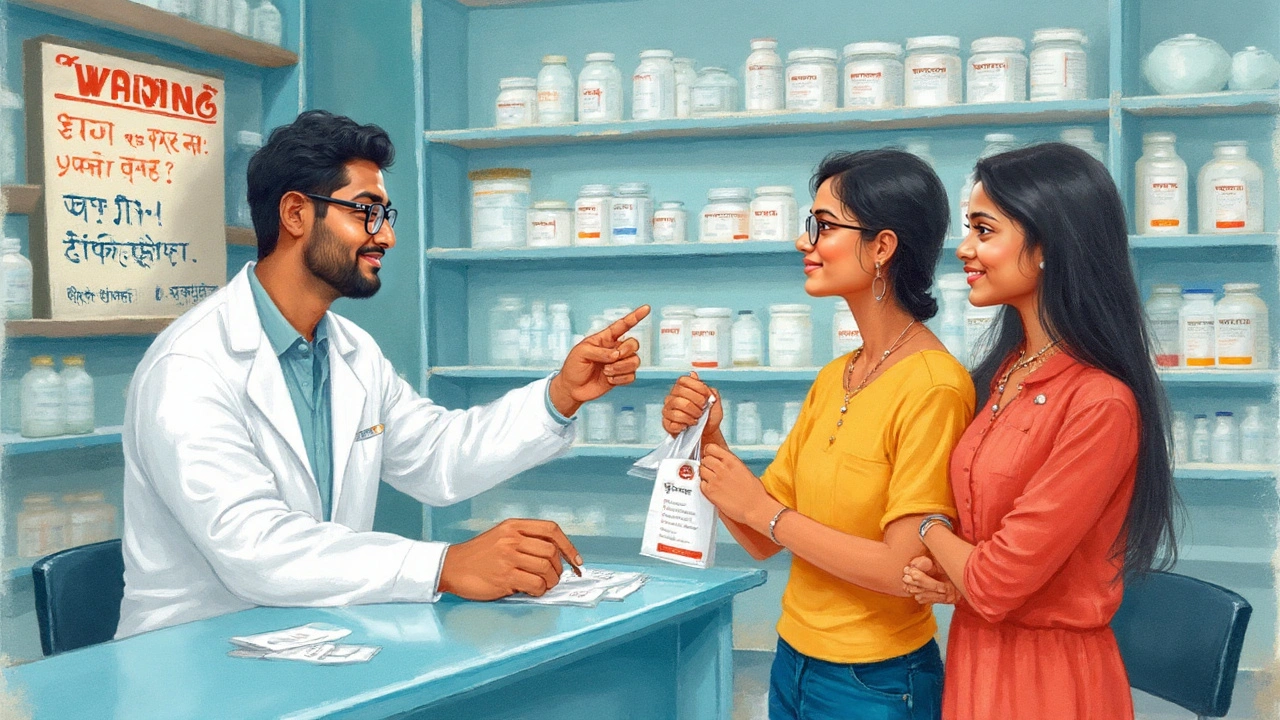Drug Combinations to Avoid: Dangerous Medication Interactions Explained
 Aug, 8 2025
Aug, 8 2025
One wrong drug combo can land you in the ER, and it’s way more common than you might think. Even medicines that sound harmless alone can trigger trouble when mixed together. It only takes a routine prescription, an after-work painkiller, and a glass of wine at dinner to spark a dangerous reaction in your body without you realizing what’s about to hit. This isn’t about rare or exotic chemicals either. We’re talking about the pills millions of people toss down with their morning coffee. Here’s what you need to know to dodge the biggest risks.
Why Mixing Drugs Can Be Dangerous
Every time you swallow a pill or sip something stronger, your body gears up to break it down. Different drugs work in different ways—some relax your brain, others drop your heart rate, and a few can make your kidneys work overtime. But when two or more of these medicines cross paths, your body is forced to juggle all their effects at once. Sometimes that juggling act goes smoothly, but often, it backfires. For example, one drug might block another’s breakdown, causing a chemical build-up that overloads your system. In other cases, one drug might make the other next to useless.
This can show up as anything from stomach pain and dizziness to life-threatening heart rhythm problems. For instance, doctors in New York found that combining certain antibiotics with cholesterol-lowering statins raised the risk of muscle damage and even kidney failure, especially in people over 60. That’s not something you’d spot from reading a tiny bottle label but it can be a seriously painful surprise.
Another classic mix-up is with blood thinners like warfarin and everyday painkillers, like ibuprofen. One slows your blood’s ability to clot while the other can thin your stomach lining. Put the two together, and you’ve got a risky recipe for internal bleeding, even if neither drug is a heavy hitter on its own. Then add in the risk of alcohol mixing with almost anything. A single drink can nullify your antibiotics or make sedatives push you into dangerously deep sleep, especially for older adults or anyone with sensitive livers.
Doctors always ask what you’re taking, from vitamins to herbal teas, for exactly this reason. Your pharmacist’s raised eyebrow isn’t for nothing, either—they’ve seen the fallout. A 2023 review found that more than one in four older Americans were at risk for harmful drug interactions purely because they neglected to mention supplements or over-the-counter meds to their main doctor. Folks tend to trust that because a medicine is easy to get, it’s safe with everything, but that’s not how the body works.
Mixing drugs isn’t just about chemistry classes—real bodies and lives are in the balance. That’s why learning how these substances interact is one of the smartest moves you can make to protect your health right now.
Common Drug Combinations You Shouldn’t Use Together
Let’s cut to the chase—some drug pairs are dangerous enough that you should never mix them without a doctor’s close supervision. This is the list that pharmacists memorize because these mix-ups happen so often:
- Antidepressants (SSRIs or SNRIs) and MAO Inhibitors: Combining these can lead to serotonin syndrome, a potentially deadly spike in brain chemical levels. Symptoms include confusion, fever, and tremors. Wait at least two weeks between stopping one type and starting the other.
- Warfarin (blood thinner) and NSAIDs (like ibuprofen, naproxen, aspirin): This combo increases the risk of severe bleeding. Even a small injury could turn into a big emergency.
- Statins and Certain Antibiotics (like clarithromycin, erythromycin): These antibiotics can make statin levels soar in your body, raising chances of muscle pain and kidney damage.
- ACE Inhibitors (like lisinopril) and Potassium-Sparing Diuretics (like spironolactone): This mix can dangerously hike potassium levels, risking heart problems.
- Benzodiazepines (like Valium or Xanax) with Opioids (like oxycodone): These both suppress breathing. Together, they’ve caused most accidental overdose deaths in the last five years.
- Metformin (for diabetes) and Cimetidine (acid reducer): This combo can mess up kidney function and boost side effects of metformin.
- Birth control pills and certain antibiotics (like rifampin): These antibiotics wipe out birth control’s effect, raising the risk of surprise pregnancies.
Some combos are obvious hazards, but others, like prescription painkillers with cough medicine, fly under the radar. Many cough syrups contain codeine or other mild opioids, which on their own are manageable, but mixed with other sedatives or alcohol, they can slow your breathing to dangerous levels.
Don’t forget over-the-counter hits like allergy meds. Mixing diphenhydramine (Benadryl) with sleep aids or anti-nausea drugs can knock out even the strongest person for hours or spark weird confusion, especially in seniors. There’s a reason “double-dipping” is a favorite caution among ER doctors.
Knowing your meds and how they act in your system saves more than just money—it can literally save your life.

Over-the-Counter Drugs and Supplements: Hidden Dangers
You’d never think a sleepy-time tea or vitamin C chew would trip up a prescription drug, but it happens all the time. Herbal remedies like St. John’s Wort, for example, speed up your liver’s ability to break down medication, which means your regular birth control or antidepressant can vanish from your blood before it’s had a chance to work. The result? Sudden mood swings, breakthrough depression, or an accidental pregnancy.
Even seemingly basic stuff like antacids don’t play well with everything. Take magnesium, calcium, or aluminum antacids within a few hours of thyroid drugs or certain antibiotics (like tetracycline), and all that good medicine can get trapped in your gut and never make it to your bloodstream. Every year, hundreds of thyroid patients see their numbers swing out of control because they popped a heartburn pill too close to their prescription.
Don’t underestimate the power of green, leafy veggies either—spinach and kale are packed with vitamin K, which directly interferes with blood thinners like warfarin. Eat a huge salad one week and nothing green the next, and your blood test could ping wildly different each time. It’s the reason why even hospital kitchens keep careful tabs on patients’ veggie servings.
Grapefruit juice is another famous troublemaker. It boosts levels of drugs like some statins, blood pressure meds, and even some allergy pills, turning an ordinary dose into a risky one. Oddly enough, orange juice is usually fine. Only grapefruit (and its cousin, Seville orange) mess with those enzymes in your gut and liver.
And about those ‘natural’ supplements: ginkgo biloba can thin your blood and shouldn’t touch aspirin or warfarin; kava and valerian root have sedative powers that can cause double-drowsiness if mixed with anxiety or sleep meds. Multivitamins aren’t always risk-free, either. Too much iron or calcium can block some antibiotics from working. The bottom line? Read packaging, make a list, and double-check it whenever you grab something new off the shelf.
Tips to Stay Safe When Taking More Than One Medicine
If you’ve got prescriptions piling up or find yourself reaching for over-the-counter fixes more often, it might be time to get strategic with your meds. Here’s how you can keep yourself safe without turning your bathroom cabinet into a war zone.
- Keep an up-to-date, honest list of every single thing you take. That means prescriptions, vitamins, supplements, and anything you buy at the grocery store or online. Bring this list to every doctor or pharmacy visit.
- Don’t be shy about asking your pharmacist to scan your medication list. They’re trained to catch combos even doctors might miss.
- If you get a new prescription, mention any medication allergies or weird reactions you’ve had before. More people have sensitivities to “inactive” ingredients—like certain dyes and fillers—than you’d expect.
- Time your medications smartly. Some meds need to be taken at least two hours apart because they block each other’s absorption. Your pharmacist can give you a sheet listing the best times for each one.
- Try using a single pharmacy for all your prescriptions if possible. This gives the pharmacist a full snapshot of everything you’re on.
- Look out for new symptoms: rashes, dizziness, mood changes, or stomach issues occurring after starting a new combo can signal a reaction. Report these immediately. Don’t tough it out.
- There’s no shame in bringing someone with you to appointments. A second set of ears helps you remember details, and they might ask questions you haven’t thought to.
- Tech can help. Use apps like Medisafe or MyTherapy to track your meds and flag possible interactions. Many pharmacy websites offer these tools too.
- Alcohol and recreational drugs add extra layers of risk. Double-check the warnings on everything you take. Mixing these with sedatives or painkillers is one big reason for ER visits on Friday nights.
- If in doubt—even for a supplement—ask. Quick phone calls save you from long hospital stays.
Paying attention now spares you hassle, pain, and confusion later. Setting a bit of time to organize and double-check your daily meds is way easier than scrambling to recover from an emergency.

The Most Harmful Consequences of Drug Interactions—and Why You Should Pay Attention
You’ve probably heard about minor side effects like a headache or nausea, but some drug interactions get deadly fast. For example, a whopping 40% of hospital admissions for people over 65 are linked to bad drug reactions, according to the FDA’s own numbers. Many started with a simple cold or muscle ache, got the wrong over-the-counter fix, and ended up with heart rhythms so out of whack they needed a defibrillator.
Prolonged QT syndrome is one of those silent killers. It sounds like medical jargon, but the gist is this: certain antibiotic and antidepressant combinations slow the electrical current in your heart. Most people feel only a flutter or dizziness—until they pass out or worse. More common is severe bleeding from NSAID-blood thinner combos. It doesn’t matter if you “feel fine” most days. Internal bleeding can creep in with no warning, leading to sudden collapse, confusion, or even stroke.
Then there’s liver failure. Some allergy or pain meds processed by your liver, when taken together, can push it past its limit. It’s behind the “yellowing” or sudden fatigue flagged on medication info sheets. Kidneys get hit, too, especially when mixing common diabetes drugs with diuretics or hypertension meds, leading to dehydration and dangerous electrolyte swings.
Don’t rely on your memory or assume pharmacists will catch everything—most rely on software, but even top programs aren’t foolproof. Keeping your own records and being cautious pays off. Families have shared stories about grandmothers ending up with irreversible confusion from Benadryl and sleeping pills, or young people landing in rehab from mix-ups between anxiety meds and painkillers. There’s no badge for being the “tough” patient who doesn’t ask questions. Real smarts come from being proactive: challenge your doctor, ask your pharmacist, and listen to your body.
You don’t need to be a medical pro to stay out of the danger zone. Pay attention to what you take, ask about possible interactions, and never ignore odd new symptoms—even if they seem small. After all, the small stuff is what often snowballs when it comes to drug safety.
